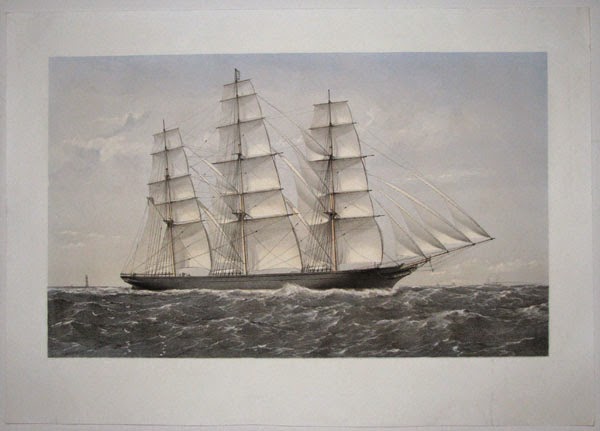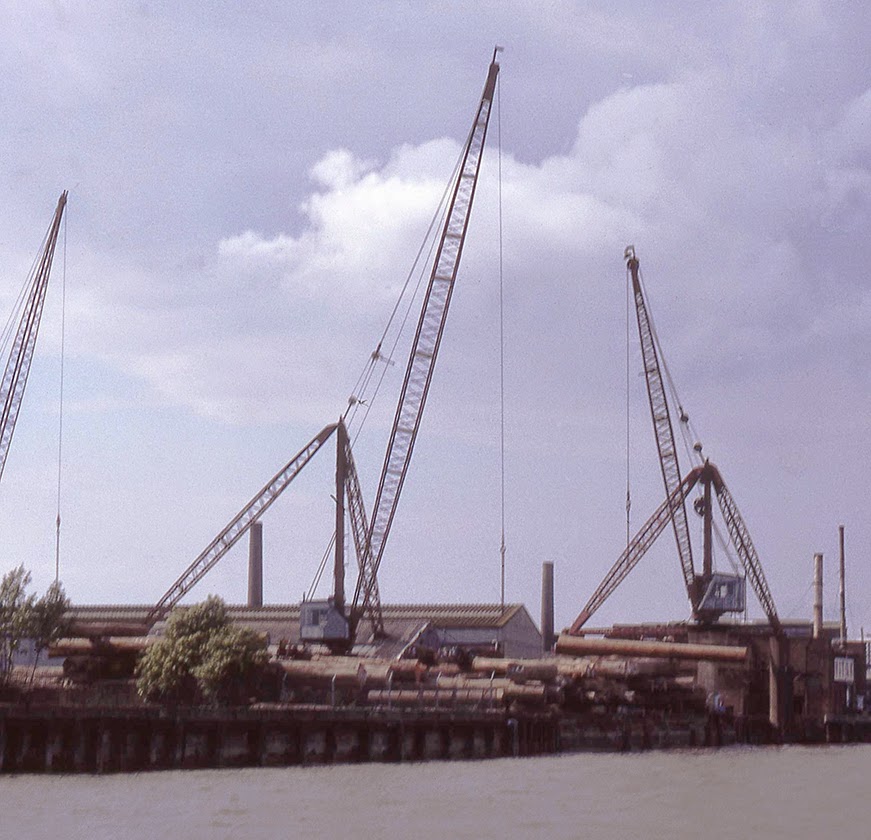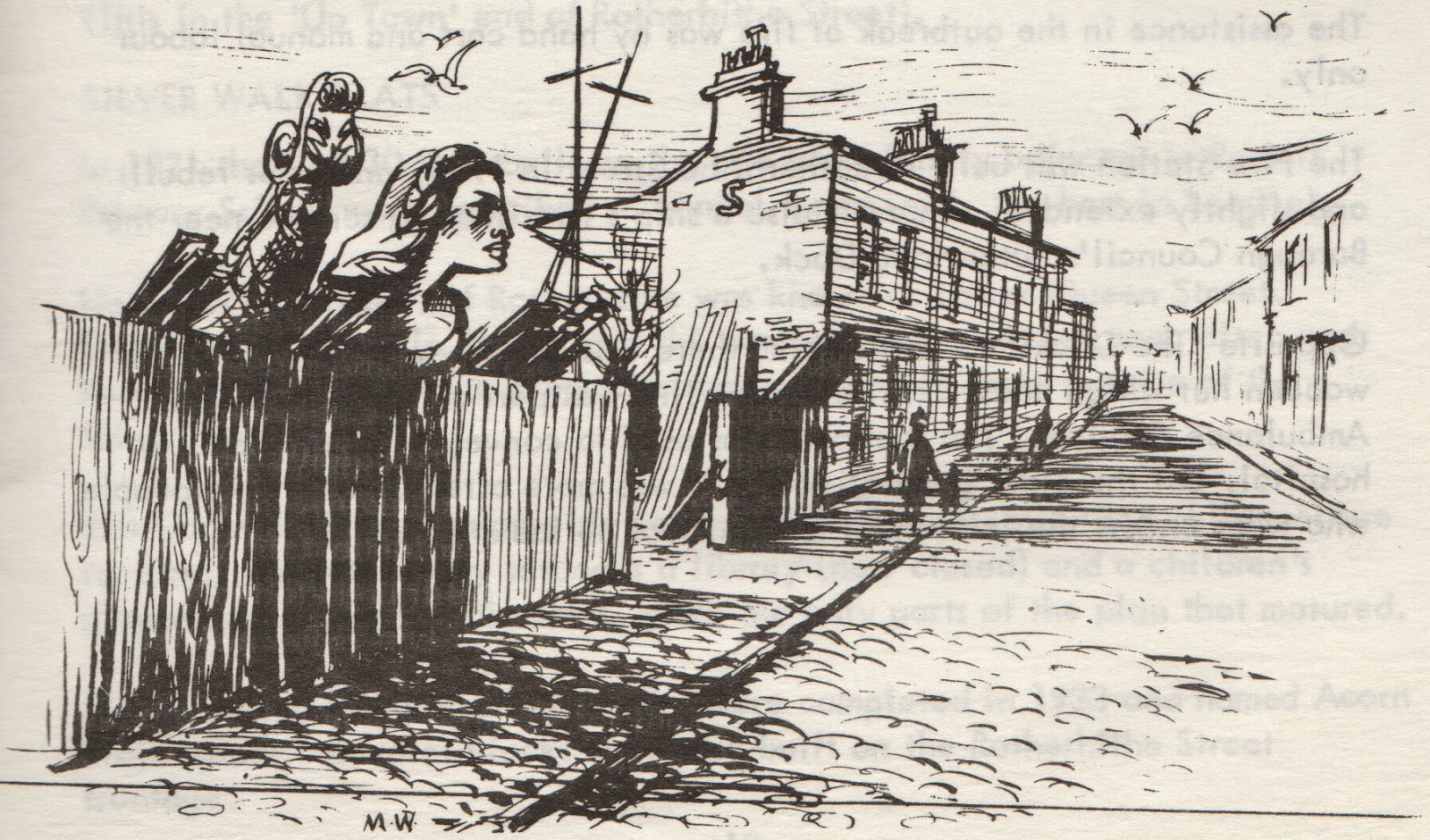 |
Detail of Rocque's 1746 map showing Lavender Street and
the shipwrights' premises that occupied the sites that later
became Lavender Dock and Lavender Wharf. The map
also shows some of the market gardens that were all
over Rotherhithe at this time, and probably gave
Lavender Street its name. |
There are a number of buildings and features named Lavender, including three that I have already covered on previous posts:
Lavender Pond, Lavender Pumphouse and Lavender lock. This post looks at the other two: Lavender Dock and Lavender Wharf. The site was immediately upriver from where the surviving Lavender Lock was built in 1862. See the location of the site at SE16 5XH on
this map on Streetmap.co.uk.
The earliest known building on the site was a windmill, dating to around
1684, but no details about it survive. Lavender Dock was the site of a shipbuilding yard from 1702 and ships were built at the site until the mid 19th Century. In the early nineteenth century the site was divided into two, Lavender Dock and Lavender Wharf. By the late 19th Century the shipyard had been filled in and it was replaced by a series of small wharf buildings known collectively as Lavender Wharf. The site was further subdivided in the early 20th Century into Lavender Wharf and Grand Surrey Wharf. All remains of the site were erased by the modern Barratts residential
development Sovereign View.
The Lavender dock, wharf and lock names come from the name
Lavender Street, which was what this stretch of Rotherhithe Street was
called during the 18th Century, shown on the Rocque map of 1746, above. Lavender Street was probably named for the growing
of lavender in the local market gardens, where I was surprised to
learn that it was a popular crop.
Unfortunately, the history of neither site forms a nice linear sequence, and the sequences of both sites are composed of bits and pieces of information cobbled together, but it is fascinating that such a small site should have such a multitude of uses over time.
All the ships mentioned in this post will be covered on future posts, if they have not already been covered.
Lavender Dock
The site was a shipbuilding yard from 1702 until 1708 when, Stuart Rankin records, Edward Swallow had the site and built ships including the 50-gun
Leopard and the 40-gun
Southsea Castle. In 1709 Swallow moved to Limehouse.
Following Swallow the yard was occupied by John Whetstone, one of a prominent family of barge and ship builders operating along the Thames. He built a 50-gun ship called
Gloucester at the yard, launched in 1745. It appears to have been his only Royal Navy commission, perhaps because it took him two years to build, which was double the time taken by other ship builders in the area to complete similar vessels. It is not recorded when Whetstone left the yard. Rocque's famous map shows the whole section of frontage along Lavender Street between being occupied by shipwrights
in 1746 (above right).
 |
Robert Inwood's frigate Southampton, built at Lavender Dock. From
British Warships in the Age of Sail 1714-1792: Design,
Construction, Careers and Fates, by Rif Winfield |
In 1756 Rankin says that the yard was in the hands of Robert Inwood who built a number of ships for the Royal Navy during his tenure at the yard including the 10-gun sloop
Spy, the 32-gun frigate
Southampton, the 28-gun
Aquilon, the 14-gun sloop
Beaver and the frigate
Boston and the 28-gun
Hussar. The frigate
Southampton deserves special mention as she was the first of a new type of ships, indicating the esteem in which Inwood was held by the authorities who entrusted him with the job.
After Inwood's departure, at some point between 1770 and 1773 the yard was held by a number of ship builders to supplement their existing operations. Immediately following Inwood, for example, the shipyard was briefly taken by the well known Peter Everit Mestaer, who already operated a number of other yards along the Thames, although he was here only briefly. Although it is not recorded which of his ships were built here, it is possible that he took the yard only to fulfil specific commissions whilst his other yards were busy, or that he expanded too far and had to reduce his holdings later on.
 |
Trethivick's Catch-Me-Who-Can.
Sourced from Wikipedia |
The site was split into two in the early 19th Century, with the dry dock and related ship building structures next to the remains of today's lock, and Lavender Wharf, as it became known, immediately downriver. The dock was taken over as a ship breakers in the name of Job Cockshott in the early 1800s. Ship breaking became a popular activity as the ship building industry went into decline, and there were several along Rotherhithe's frontage. Ships were broken up and sold off for their parts. Most valuable was their wood and their metal fittings, but even old rope had a certain value, as it was processed and re-worked into other products. Many famous naval warships met their ends at ship breakers like this. Job Cockshott operated from the yard until 1824, when he died. He invested in property in the immediate area, was a shareholder in the Commercial Docks Company, owned two ships of his own, and had an interest in Lavender Wharf. Job Cockshott's story intersects with that of the engineer Richard Trevithick. Trevithick is notable for many reasons, whose previous connection with Rotherhithe was the failed attempt to tunnel under the Thames at Rotherhithe before Sir Marc Brunel's successful Thames Tunnel, and this will be covered on another post. At the time of his meeting with Job Cockshot he had premises nearby and was working on a number of projects to develop ship and dock related machinery. His most famous invention was the high pressure steam engine to power his
Catch Me Who Can railway locomotive, which was displayed with great fanfare in July 1808. The
Catch Me Who Can was not, however, a commercial success, attracting crowds, achieving enduring novelty status, but no investment. Trethivick presumably went into business with Cockshott to reduce his losses and they entered into an agreement to install the locomotive's machinery in the former Lord Mayor's State Barge to power an internally installed paddle wheel. Unfortunately the story ends there, and nothing seems to have come from the venture.
 |
Lavender Wharf and Lavender Dock.
Rotherhithe Rating Valuation Plan 1862.
From Stuart Rankin's Shipbuilding in Rotherhithe No. 4b |
The next couple of decades are unclear, and the site was probably used for various small ventures, including ship breaking, repairs and barge building. However, by 1865 the shipyard had passed into the hands of John and William Walker and it entered another great ship building phase, this designing and building commercial rather than naval ships. Of John Walker there is no surviving record,
apart from the name of the business, although he was clearly related to
William Walker. William Walker was a shipbuilder who operated, at
different times, out of Rotherhithe, Deptford, Poplar and Millwall.
William Walker specialized
in composite ships. It was here that the Walker brothers built the composite clipper ship Mikado (upcoming post) and the subsequent three composite clippers about which I have already written:
Shun Lee, Ambassador and
Lothair. Clippers were originally designed to serve the China tea industry, and were used in the Antipodean wool industry as well. Sleek cargo carriers with tall masts and vast billowing sails, they were designed for speed. Originally made purely of wood, they were improved by the use of iron frames to reinforce the structural integrity of the ships and expand the available storage space. These composite ships came at the end of the age of the wooden tea clippers, and are amongst the most beautiful and successful. The Walkers'
Lothair was one of the fastest ships of her day, her speeds comparing to those of the more famous
Thermopylae and
Cutty Sark. Lovely
Lothair, launched in 1870, was the last large sailing ship to be built in a Rotherhithe shipyard.
 |
Ambassador, built by William Walker
at the Lavender Dock (Thomas J. Duggan 1869) |
Lavender Dock was marked on the 1868 Ordnance Survey map, and James Turner had the dock from October 1873 to 1886, and was succeeded by John Medhurst who was there until at least 1890, but the dry dock had vanished on the Ordnance Survey map by 1894, by which time it had been filled in and the entire site was now marked as Lavender Wharf. There is a lot of overlap between the dock and the wharf, with wharf buildings being occupied at the same time as the dock site from at least the early 19th Century.
Lavender Wharf
Wharves are a nightmare to find out about from secondary sources. I've already posted about other wharves and have found that as with many of the almost countless other wharves around Rotherhithe, it is frustratingly difficult to find out much about any of them. Many of them had additional buildings added and removed over time, and not all of the available maps show these transformations. Many of them had name changes, which make them difficult to trace in records. Wharves habitually changed hands many times, sometimes with new owners, sometimes new leaseholders, and tracing their histories
is often more a matter of listing names of successive owners rather
than learning much about how individual buildings were used, what
cargoes were handled and what their owners were like and where they came
from. Lavender Wharf is unfortunately no different.
 |
Lavender Wharf and Dock, from the 1843 Rotherhithe
Rating Valuation Plan. From Stuart Rankin's
Shipbuilding in Rotherhithe No. 4b. |
Lavender Wharf was a river frontage and buildings immediately down river of the Horseferry Stairs, which divided it from Horseferry yard. It was built over part of the shipbuilding
yard of Lavender Dock, which it eventually replaced, and wharf premises co-existed with the dock for many decades. The company Beech, Whitaker and Brannon had Lavender Wharf until 1818, when they published in the London Gazette to announce that the partnership had been dissolved but it is by no means clear what they did. As wharfingers they would have handled cargo delivered by boat, but whether they specialized in a particular cargo or handled general content is unknown. According to an anonymous comment on a previous post, the James Brannon of the partnership lived from 1762-1818, so the partnership seems to have been dissolved on his death. Job Cockshott had an interest in the wharf between around 1806 to 1824, apparently an extension of his shipbreaking activities at the Lavender Dock. The overlap in these two sets of dates can probably be accounted for by the fact that Lavender Wharf was made up by a number of different buildings.
Following the death of Job Cockshott in 1824, Cockshott's Lavender Wharf lease was taken over by Thomas Beech, also for ship breaking. On the Rotherhithe Rating Valuation Plan of 1843 it is shown as "Lavender Stone Wharf, Mr Manuelle," and there are seven buildings shown, four of which are labelled: sheds, dwelling, blacksmith's shop and granary. The granary was probably the former mould loft, adapted to a granary after the site ceased to be used for ship building. Mould lofts were large flat surfaces that were used to draw out the hull and cross-sections of the ship, drafted by loftsmen, which were then used for templates for building ships. In 1862 William Walker had amalgamated the dock and the wharf until around 1870, when the wharf and the dock were again leased as separate units and the wharf was leased to William Lund. It seems likely that he is the same as the William Lund who commissioned
Ambassador from the Walker. W. Lund and Sons established the Blue Anchor delivery line in 1869, and
Ambassador
was purchased as the primary ship of the brand new line particularly
for the tea trade. In 1895 part of the site was leased by a chicory manufacturer.
 |
Lavender Wharf in 1914, highlighted, which is flanked by
Grand Surrey Wharf and Lavender lock |
Between the 1890s and the late 1930s a number of Lavender Wharf buildings were collectively occupied by W.B. Dick and Company (their registered premises was 233 Rotherhithe Street), which handled barrels of oil, delivered by river and stored in large tanks behind the premises. The 1914 Ordnance Survey map shows that the site had now been further divided into two, with Lavender Wharf occupying the downriver part of the site next to Lavender Lock, and Grand Surrey Wharf occupying the upriver section. W.B. Dick also occupied a building on the other side of the Lavender lock, and operated a number of motorized barges from its premises. A rather nice account in
London Night and Day 1951 describes how the W.B. Dick site could be distinguished by its aroma: "In fog, pilots smell their way upriver. Well, this is one of the places they smell. And the distinctive smell is that produced in the processing of mineral lubricating oils." One wonders quite what the smell was. W.B. Dick expanded to take in Grand Surrey Wharf. The oil containers, five of them, are still shown on the 1984 Docklands History Survey.
 |
| Lavender Wharf in 1937, when it was the premises of W.B. Dick and Co. |
Today
Nowadays the land it inhabited is occupied by a modern pseudo-Regency
residential development named, somewhat grandiosely given its dubious architectural merit, Sovereign View, running along the Thames Path. I wonder which
sovereign the developers (Barratts) may have had in mind when they
named it?
 |
The site of Lavender Dock and Lavender Wharf today,
seen from the Thames. Lavender lock is at far left.
Courtesy Google Maps. |



%2B-%2Bbri.jpg)















